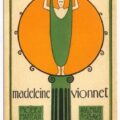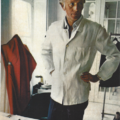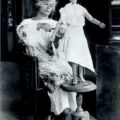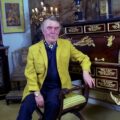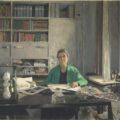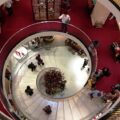Successful Women Designers – Jeanne Paquin
June 22, 2019Jeanne Paquin was one of the most famous figures in couture during her 30 years as a top designer at the beginning of the 20thcentury. She was active from 1891 to 1920. An astute businesswoman, she opened branches worldwide, employed 2,700 people at her peak, and designed for theatre and for actresses, a move which many of the more snobbish couturiers refused. Jeanne Paquin dresses were known as chic yet practical, a little daring yet not really extreme, and all in all, very wearable. Jeanne Paquin designs were immortalised in books of the period and anybody who had any thoughts on fashion and culture knew her name.
Maison Rouff
One of the first top female fashion designers, Jeanne Marie Charlotte Beckers was born in in 1869. Her father was a doctor and she was one of five children. As a young teenager, she was apprenticed to a neighbourhood dressmaker, moving to the house of Maggie Rouff a few years later. At Maison Rouff she was able to rise through the ranks and attained the rank of Premiere, the head of the workshop.

Jeanne Paquin design of 1903. Image via Wikipedia. Jeanne Paquin designs.

‘Five Hours at Paquin’ by Henri Gervex, 1906. Image via Wikipedia. Jean Paquin designs.

Jean Béraud, La Rue de la Paix, 1907. Paquin’s shop is on the right with the gold sign. Image via Wikipedia. Jean Paquin designs.

1912 dresses designed by Léon Bakst for Paquin. Image via Wikipedia. Jean Paquin designs.

1913 theatre coat in Gazette du Bon Ton. Image via Wikipedia. Jeanne Paquin designs.

1914 evening dress. Image via Wikipedia. Jeanne Paquin dresses.

1917 evening dress. Image via Wikipedia. Jeanne Paquin dresses.

1926 evening dress. Image via Wikipedia. Jeanne Paquin dresses.

1939 evening dress designed by Ana de Pombo. Image via Wikipedia. Jeanne Paquin dresses.
Paquin Freres
In 1891 Jeanne married the businessman Isadore Rene Jacob dit Paquin. He owned a menswear shop which had been called Paquin Freres, back in the 1840s, before evolving into a couture business called Paquin Lalane. As a wedding present, Isadore gave Jeanne creative control of the business, whilst he remained to work behind the scenes. They renamed it Paquin. Its address of 3-5 Rue de la Paix was one of the chicest in Paris, right next to the House of Worth.
Jeanne Paquin – an Eloquent Designer
Madame Paquin, as she was always known, had always been confident and sociable. Now she had a place in society with a wealthy husband, and her own business to give her opinions credit. She firmly believed that fashion was a valuable part of culture, and wrote many very well worded magazine articles and gave interviews stating her case. She was also very keen on the cycle of fashion. Maggy Rouff, whom she had worked for, is quoted as saying “I can still hear the crystal voice of Madam Paquin [saying that fashion] must constantly renew itself, without weakness or fear, even with audacity.”
Actually, Paquin’s designs weren’t really audacious. As a woman, she wanted to make clothes that were beautiful yet practical. Because of this, they were actually far more moderate than the extreme fashions put out by some of her male contemporaries. She pioneered the day-to-evening gown in a tailored dress with soft draped touches that would be suitable for both situations. Her sports clothes, made for ease of movement while motoring or playing golf, were also commended for their wearability away the road or golf course. Any woman could break her journey or take a break in her game to lunch at a hotel and still look smart.
39 Dover Street
By 1896 the Paquins had opened a London store at 39 Dover Street. The young Madeline Vionnet was made Premiere of the workshop. Most Paris couture houses with London branches (such as Schiaparelli which operated decades later) liaised with the Paris house to have exactly the same models available, although they were measured and made up in London. It is probable that the London branch of Paquin, however, had its own design team. It’s not known who that was at the start, but the Italian born designer Bianca Mosca was appointed head designer there in 1949 until her premature death in 1950. The London premises were destroyed during the Blitz but the business moved to a new address in the capital, eventually closing at the same time as its parent company in the 1950s.
Jeanne Paquin – Worldwide Stores
The London store was followed by shops in Madrid, Buenos Aires and a Paquin-Joire furrier on Fifth Avenue, New York which she ran with her half-brother, Henri Joire. As a couturier Paquin was known for elevating her designs using creative fur trims in unexpected ways so a furrier made sense. She was the first Parisian couturier to take the step of opening branches in other cities and many followed her lead.
An Artist of Fashion, Criticised for Being too Commercial
But this success sometimes worked against her. Critics were shocked at her commercial streak. It wasn’t only that she opened multiple branches. Nor that she expanded her couture business to include sports sections, lingerie, fur and accessories departments. It was the fact that her designs were available to any who could afford them, and actually, her prices were modest enough to include many more than other couturiers did.
A Paris guidebook of 1906 said: “From the first, this clever and ornamental young couple followed a new system. No haughty seclusion, no barred doors, at the Maison Paquin.” Their customers included many whom others would not dress, like the famous courtesans Liane de Pougy and La Belle Otero. The queens of Spain, Portugal and Belgium were also customers, seemingly undeterred by their neighbours in the changing rooms. Paquin went as far as to build a stage at the salon so that actresses could see how outfits would work under the footlights. Jeanne Paquin believed in the cross-fertilisation between fashion, theatre, art and architecture.
Prix Isidore Paquin
When Isadore died in 1907, Jeanne set up a prize in his name for young artists, the Prix Isidore Paquin. In 1911 she commissioned the leading artists of the day to illustrate her work. George LePape, Georges Barbier and Paul Iribe created an album of beautiful designs for accessories, fans and clothes. This album, hand printed using the time-consuming pochoir process was an artwork in its own right.
In 1912, along with six other leading Paris fashion designers she signed an exclusive contract with the very upscale fashion publication la Gazette du Bon Ton which cemented her reputation as “an artist of fashion”. Yet it was well known that however genuine her love for the arts might be, there was also a distinct commercial advantage in supporting the avant-garde. It lent the brand a certain edge to be associated with them, much as today arts festivals are sponsored by brands.
Jeanne Paquin Designs
Although she began her design career creating clothing inspired by romantic and flouncy pastel coloured eighteenth century evening dresses, a few years later she changed tack entirely and became enamoured with black. It was a formal shade used only for mourning at the time, but Paquin re-invented it. She used it as a base to make her favourite rich, bright accent colours shine more brightly. Black cloaks would have colourful embroidery and open to reveal flashes of a glorious lining colour. She was also unusually fond of scarlet. In fact, her method of designing was to start with a colour and design the outfit around it.
By the 1900s, her colour sense was revelling in the vogue for jewel-toned Orientalist clothes. She commissioned the designer for the wildly popular Ballet Russe, Leon Baskt, to create some exclusive designs for Paquin.
Edith Wharton namedropped Maison Paquin when dressing her rich and elaborately clothed protagonists for a wedding in 1905’s House of Mirth. When a character describes the wedding dress: “We knew at once, from a fold in the back, that it must have come from Paquin.” The recognisable “Fold” refers to Paquin’s inspiration from the origami-like folds of Japanese kimonos and obi sashes.
Spat with Paul Poiret
Another trend of Poiret’s that she added to her own repertoire was the hobble skirt. However, instead of the very impractical version that the other designer sold, which restricted the stride by its very nature, her model had discreetly inserted extra panels of fabric for ease of movement which provided the look without the humiliating hobble.
Paquin did not approve of Poiret’s ideas in other, more overt ways too. When he designed harem pants in 1911, many were shocked. Paquin added her voice to the chorus of disapproval, declaring them “unaesthetic”. When the Callot Souers introduced narrow skirts in 1912, she mutinously made her own skirts fuller in response.
Jeanne Paquin Dresses
One of her most celebrated designs was the Tango dress of 1913, made with lightly floating layers of chiffon underskirt, tulle overskirt and tunic. Of course she incorporated pleats and godets aplenty to provide freedom of movement without in any way exposing the wearer, and the movements of the dance itself were also studied so that the dress looked fantastic in motion. The tango was a scandalous and fashionable new dance and in creating a whole fashion collection based around it by making the same shape in different colours and fabrics Paquin piqued the interest of the press.
It was also in 1913 that she won the Légion d’Honneur, becoming the first female dressmaker to do so. That year, her shareholders received a 211% return on their investment. “I am glad that the government has acknowledged my work quite irrespective of sex. That is far as my feminism goes. I only want justice, that work in any particular branch in which a woman excels shall be recognised,” she commented.
International Exhibitions
In 1900, the House of Paquin exhibited at New York’s World Fair, along with 19 other couture houses which included her old employer, Maison Rouff, and her next-door neighbour, the venerable House of Worth.
By 1907, much to the surprise of some of her contemporaries in the fashion world, she was named as the organiser of the fashion section of Paris’s huge Exposition Universelle. Amongst other beautiful dummies dressed in lavish ball gowns, her display contained an excellently dressed wax mannequin of herself. She also designed the clothing for the huge statue of La Parisienne which loomed over the entrance to the exhibition. It was all a big success.
Between 1910 and 1915, Paquin took part in several international exhibitions. They provided great publicity. The Paquin Pavilion in Turin’s International Exhibition of 1911 was decorated like a Greek Temple and was so popular that Paquin started to charge the visitors an entrance fee. It was not enough to put people off and the Temple was still overcrowded.
The Crusade of Elegance
Paquin innovated the practice of sending haute couture dressed models to Longchamp and Chantilly racecourses. These had always been places where the most fashionable people went to show off their latest outfits and to check out what other people were wearing. Paquin was the first to infiltrate these fashionistas with professional beauties wearing her designs.
In 1914, the outbreak of war encouraged Paquin to explore new markets. The best prospect was America, where her fur shop had been thriving for the last two years. Now, Paquin sent over four of her top models who, accompanied by her sister in law Madame Joire, toured the USA. Over three weeks they visited New York, Boston, Philadelphia, Pittsberg, and Chigago, returning to New York at the end.
Wearing Paquin designs and pastel wigs, the croisade de l’élégance – Crusade of Elegance – wowed the crowds who were at first charged $3.00 to see the parade and then $5.00. As with the charge for her pavilion in Turin, this not inconsiderable sum didn’t stop the crowds. Incidentally, she was not the first couturier to do this. Paul Poiret had toured his models to great delight the year before, but Paquin’s version was still newsworthy.
Design Piracy
This kind of popularity had its downsides, however. Copying of couture was rampant, often aided by employees who leaked details of designs to magazines, department stores and even rival couture houses for a fee. In 1906, Paquin sued two magazines who had published photographs of several new designs before they were officially released. That year she also won a very long running case against rival couturiers Beers for copying her work, receiving 8,000 francs in damages. Another case against a different Parisian tailoring firm which was launched in 1911 took seven years to resolve, but she won this one in the end too.
In 1914 Paul Poiret created the Sydicate for the Protection of the Great French Couture and Related Industries, which was intended to combat piracy. Paquin joined this group but the complicated and strict rules actually harmed the couturier’s legitimate overseas trade and owing to this and also Poiret own growing bad reputation which they didn’t want to be associated with the group dissolved only a couple of years later.
President of the Chambre Syndicale de la Couture
In 1917 Paquin’s status was officially recognised when she was appointed President of the Chambre Syndicale de la Couture. The Chambre Syndicale represented all the couturiers of Paris, and she held the prestigious post until 1919.
Jeanne Paquin retired from her house whilst it was at the peak of its fame in 1920. She was 51. She died, still famous, in 1936 at the age of 67.
The House of Jeanne Paquin
In a thoroughly modern fashion, the business didn’t close when Jeanne Paquin retired. Madeline Wallis, her assistant, took over. Wallis was particularly creative with fur. In 1936, the mantle was passed to Wallis’s own assistant, Ana de Pombo. She was head designer until 1941. De Pombo, who was Spanish, took the House into a rather colourful turn. After that, De Pombo’s assistant Antonio del Castillo took the reigns. He was there for only four years, until 1945. This was a very difficult term, as France was at war and Paris and its fashion industry was subject to the rule of the German occupation.
The next head designer at Paquin was Colette Massignac. She had perhaps an even more difficult task, that of rebuilding the brand’s post-war reputation. In the face of new and exciting innovations from designers like Christian Dior and his “New Look”, it was starting to look less than fresh. She held the post until 1949. From then until 1953, Lou Claverie, who was a designer of Basque background, headed the label. His designs reinvigorated Paquin, showing wit and a sense of humour. Alan Graham was next. The fashion press were surprised by his appointment. He was a young and relatively unknown American designer. But his minimalist, youthful designs weren’t the hit the brand were hoping for, and the House of Paquin closed on 1 July 1956.




